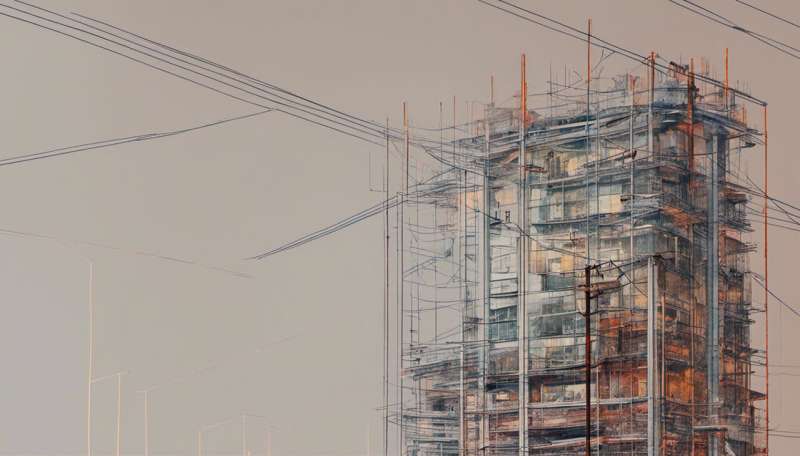This article has been reviewed according to Science X's editorial process and policies. Editors have highlighted the following attributes while ensuring the content's credibility:
fact-checked
trusted source
written by researcher(s)
proofread
One in four Australian households struggle to pay power bills. Five ways to tackle hidden energy poverty

One in four Australian households are finding it hard to pay their gas and electricity bills. As winter looms, energy price rises will make it even harder. Cold homes and disconnections resulting from energy poverty threaten people's health and well-being.
Income support for welfare recipients
and retrofitting homes to make them more thermally efficient—by adding insulation, for example—can ease the burden. And when homes are not too cold or hot, people's health benefits. This in turn
However, many people are missing out on assistance as programs often do not recognize their difficulties. Their energy vulnerability is hidden.
What forms does hidden energy poverty take?
Our newly published study has revealed six aspects of hidden energy vulnerability. These are:
-
underconsumption—households limit or turn off cooling, heating and/or lights to avoid disconnections
-
incidental masking—other welfare support, such as rent relief, masks difficulties in paying energy bills
-
some households disguise energy poverty by using public facilities such as showers or pooling money for bills between families
-
some people conceal their hardship due to pride or fear of legal consequences, such as losing custody of children if food cannot be refrigerated because the power has been cut off
-
poor understanding of energy efficiency and the health risks of cold or hot homes adds to the problem
-
eligibility criteria for energy assistance programs may exclude some vulnerable households. For example, people with income just above the welfare threshold are missing out on energy concessions. Energy retailer hardship programs also ignore people who have voluntarily disconnected due to financial hardship.
Our studies suggest trusted intermediaries such as people working in health, energy and social services can play a vital role in identifying and supporting such households.
First, energy efficiency and hardship initiatives may be integrated into the My Aged Care in-home care system. Energy poverty risk identification, response and referral could be built into the national service's assessment form. This could leverage existing client screening processes.
The system's front-line staff could connect at-risk householders with energy counselors. These counselors could help people access better energy contracts, concessions, home retrofits and appliance upgrade programs.
A new Commonwealth "energy supplement" could help pay for essential energy-related home modifications. This would help avoid My Aged Care funds being diverted from immediate healthcare needs.
Second, general practitioners and other health professionals could help identify energy vulnerability among patients with medical conditions of concern. They could also provide letters of support emphasizing renters' health-based need for air conditioners or heaters.
Third, energy providers could use household energy data to identify those that seem to be under-consuming or are often disconnected. They could also identify those that are not on "best offer" deals. They could be proactive in checking struggling householders' eligibility for ongoing energy concessions and one-off debt relief grants offered by states and territories.
Energy providers could also make it easier for social housing providers to ensure concessions for tenants renew automatically.
Fourth, local councils could use their data to identify at-risk householders. They might include those with a disability parking permit, discounted council rates or in arrears, on the social housing waiting list, Meals on Wheels clients and social housing tenants. Maternal and child health nurses and home and community care workers making home visits could call attention to cold or hot homes.
Councils could employ in-house energy counselors to provide assistance and energy literacy training. Council home maintenance teams could develop bulk-buying, insulation and neighborhood retrofit programs.
Strategies to reduce vulnerability to energy poverty should be part of municipal public health and well-being plans. Under these strategies, net-zero-carbon funds set up by states and local councils to reduce emissions could finance targeted housing retrofits.
We also suggest setting up a central helpline to improve access to energy assistance via local referrals.
Fifth, residential energy-efficiency programs could become more person-centric. For example, we already have Residential Efficiency Scorecard audits to assess the thermal quality of a home. These audits could also explore whether concessions and better energy deals are available to the household.
Building capacity at all levels
Capacity-building strategies are needed at all levels—individual, community and government—to overcome the challenges of reducing energy poverty. Current obstacles include the competing priorities of service providers, lack of time and resources, and poor co-ordination between siloed programs and services.
Access to essential energy services should be part of state and local governments' strategic health plans. Housing, energy and health departments could work together to include housing retrofits in preventive health programs.
A comprehensive approach is needed to overcome hidden energy poverty. It must include public education, integrated services and well-funded energy-efficiency programs. Regulatory reforms and ongoing funding are both needed to improve the availability of energy-efficient, affordable homes for tenants.
Our suggested strategies start with improving the skills and knowledge of trusted intermediaries. Doctors, social workers, housing officers, community nurses and volunteers can play a central role. Using these front-line professionals to help identify and act on energy poverty offers a novel, cost-effective and targeted solution.
This article is republished from The Conversation under a Creative Commons license. Read the original article.![]()
















